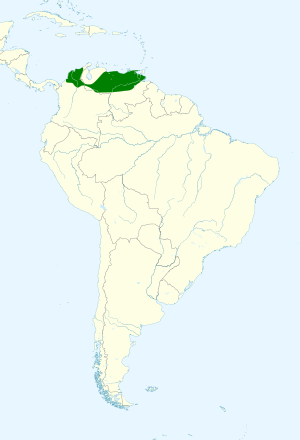Stripe-backed wren facts for kids
Quick facts for kids Stripe-backed wren |
|
|---|---|
 |
|
| Conservation status | |
| Scientific classification | |
| Genus: |
Campylorhynchus
|
| Species: |
nuchalis
|
 |
|
The stripe-backed wren (scientific name: Campylorhynchus nuchalis) is a cool bird that lives in the savannas of northern Colombia and central Venezuela. You can find these wrens in dry forests, woodlands near rivers, or on farmlands. They usually live in areas up to 800 meters (about 2,600 feet) above sea level.
Contents
Family Life and Reproduction
The stripe-backed wren is famous among scientists because it's a great example of co-operative breeding. This means that more than just the parents help raise the young.
Living in Groups
These wrens live in groups that can have anywhere from 2 to 10 adult birds. But here's the interesting part: usually, only one pair in the group lays eggs. This happens at the start of the rainy season, which is from May to September.
Helping Hands
Even though only one pair breeds, all the birds in the group work together. They help protect their territory from other birds. They also all help feed the baby wrens, both when they are still in the nest and after they learn to fly. Because of this, the non-breeding birds are called "helpers at the nest."
Who are the Helpers?
The birds that don't breed are usually the children or brothers and sisters of the breeding parents. After a year or two, female wrens often leave their family group. They then join another group as helpers, usually in a nearby area.
Male wrens, however, often stay with their original family. If they survive, they might even become the main breeding male in the future. If the current breeding male dies or leaves, the oldest male in the group usually takes his place.
Bird Song and Family Calls
Some of the calls made by stripe-backed wrens are unique to each bird. These special calls can even be passed down from father to son. This is a possible example of a "dialect" forming in bird song. These special family calls seem to help the group members stay in touch with each other.
Appearance
Both male and female stripe-backed wrens look very similar. You can't tell them apart just by looking at them. This is common in bird species where both parents help equally with raising the young.
See also
 In Spanish: Cucarachero chocorocoy para niños
In Spanish: Cucarachero chocorocoy para niños


